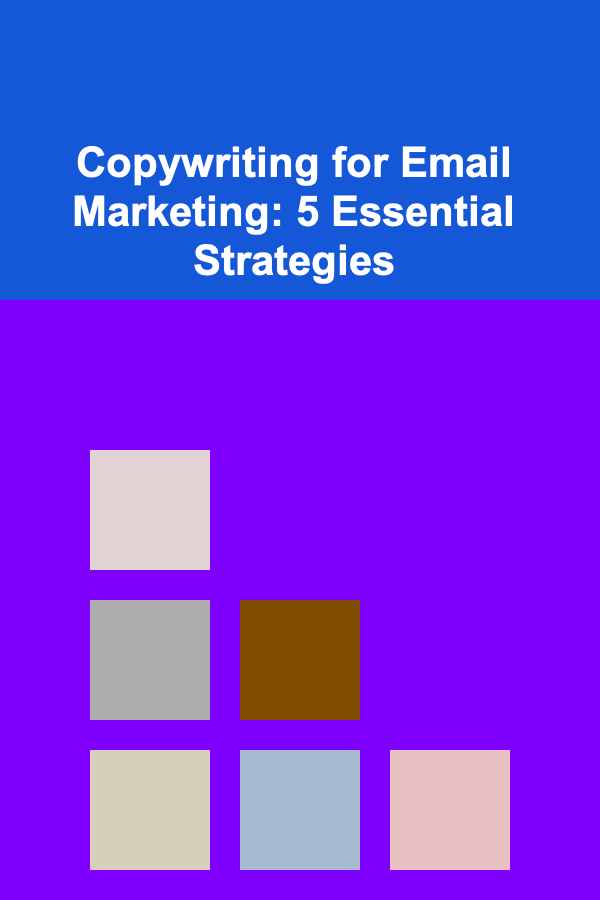
Copywriting for Email Marketing: 5 Essential Strategies
ebook include PDF & Audio bundle (Micro Guide)
$12.99$9.99
Limited Time Offer! Order within the next:

Email marketing is one of the most powerful tools in a marketer's arsenal. According to various industry reports, email marketing boasts an ROI of up to 4400%, making it a highly effective strategy for driving customer engagement, conversions, and loyalty. But, to achieve these results, one needs more than just an email list---one needs compelling copy that resonates with the audience.
The success of email marketing campaigns often hinges on the strength of the copy within them. If your email content isn't captivating, relevant, or engaging, then your carefully curated list of email addresses won't bring in the results you expect. Crafting effective email copy requires strategy, creativity, and a deep understanding of your audience.
In this article, we will explore five essential strategies for writing powerful email marketing copy that not only captures attention but also drives conversions.
Craft Compelling Subject Lines
The subject line of your email is the first (and sometimes only) thing your recipients see in their inbox. If your subject line fails to grab attention, your email may never even be opened. In fact, about 33% of recipients decide whether to open an email based solely on the subject line, so it is crucial to make it count.
Here are some best practices to create compelling subject lines:
A. Be Clear and Concise
Clarity is key when it comes to subject lines. Your recipients should immediately understand what the email is about. Avoid vague or overly complex language that may confuse the reader.
- Example : "Increase Your Sales by 30% This Month"
This subject line is clear and gives the reader an immediate idea of what to expect from the email.
B. Create a Sense of Urgency
Urgency can motivate recipients to open your email immediately, especially if you're offering a time-sensitive discount, promotion, or limited-time offer.
- Example : "Last Chance! 50% Off Your Favorite Items"
This type of subject line plays on FOMO (fear of missing out), prompting action right away.
C. Personalize When Possible
Personalization is an effective way to increase email open rates. Using the recipient's name or referencing past interactions (like previous purchases) makes the email feel more tailored.
- Example : "Jane, Your Special Offer Awaits"
Personalized subject lines have been shown to increase open rates by 26%.
D. A/B Test Your Subject Lines
Testing different subject lines can give you valuable insights into what resonates with your audience. A/B testing allows you to compare subject lines and see which one yields better results.
Focus on the First Few Lines
Once the recipient opens your email, the next key factor is the body copy. The first few lines are especially important because they can determine whether the reader continues reading or unsubscribes. Many email clients, like Gmail, only display the first 40-50 characters of the email body in the inbox preview, so you must make those first few lines impactful.
Here's how you can optimize those initial lines:
A. Make It Relatable
The opening lines should immediately speak to the recipient's needs, desires, or pain points. Understand your audience well enough to speak their language and address their specific concerns or interests.
- Example : "Tired of slow website load times? We've got a fix for you."
This opening line acknowledges a common problem and offers a solution, encouraging the reader to continue.
B. Offer Value Right Away
Don't make the reader wait for the good stuff. Let them know upfront what they'll gain by reading the email. Whether it's a discount, helpful tips, or an exclusive offer, let them see the value in the first few lines.
- Example : "Get 20% off your next purchase, just for being a loyal customer!"
This immediately offers value and entices the reader to keep going.
C. Create Curiosity
Another way to hook your audience is by sparking curiosity. This can make the reader want to open the rest of the email to find out more.
- Example : "This simple hack will change how you think about productivity..."
By piquing curiosity, you create a sense of intrigue that can increase engagement.
Write Copy That Speaks to Your Audience's Needs
Effective email copy should always be customer-centric, meaning it focuses on the needs, desires, and challenges of your audience. When writing your email, put yourself in the shoes of the recipient and ask: "What do they want, and how can I deliver it to them?"
A. Identify Pain Points
Understanding the challenges your audience faces will allow you to craft messages that truly resonate. If you can address a specific pain point or need, your email will feel much more relevant and helpful.
- Example : "Struggling to find time for self-care? We've got five quick skincare tips that can fit into your busy schedule."
By focusing on a relatable problem (lack of time) and offering a solution (quick skincare tips), you're showing the value upfront.
B. Speak Their Language
The tone and language of your email should align with your audience's preferences. If your audience is primarily young professionals, a casual and friendly tone may be most effective. For a more corporate audience, you might opt for a professional and polished style.
- Example (for a young, casual audience): "Hey there, ready to level up your skincare routine?"
- Example (for a corporate audience): "Enhance your professional image with these grooming tips."
C. Use Storytelling
People love stories. Integrating a short, compelling story into your email copy can help humanize your brand and build an emotional connection with your audience.
- Example : "When Sarah first tried our product, she was skeptical. But after just one week, she noticed a huge difference. Here's how it helped her..."
This storytelling approach creates engagement by sharing real experiences and outcomes.
Include a Strong Call to Action (CTA)
A call to action (CTA) is the part of your email that tells the reader what you want them to do next. Whether it's to make a purchase, sign up for a webinar, or download an e-book, your CTA should be clear, compelling, and action-oriented.
Here's how to craft an effective CTA:
A. Use Action-Oriented Verbs
Start your CTA with a verb that encourages the reader to take immediate action. For example, words like "Get," "Download," "Start," or "Shop" are action-oriented and prompt behavior.
- Example: "Shop Now," "Get Your Discount," "Start Your Free Trial."
B. Create Urgency
Encourage immediate action by creating a sense of urgency. Phrases like "Limited Time Offer" or "Only 24 Hours Left" can push the reader to act sooner rather than later.
- Example: "Claim Your Spot Before It's Too Late."
C. Make It Stand Out
Your CTA should be visually distinct and easy to find. Use buttons, bold text, or contrasting colors to make the CTA stand out in the email body.
- Example: A large, colorful button that says "Buy Now" is more likely to grab attention than plain text.
D. Limit the Number of CTAs
Avoid overwhelming your reader with too many choices. Ideally, you should include one main CTA per email. If you need to include secondary actions, such as "Learn More" or "Contact Us," make sure they are less prominent.
Test and Optimize Your Email Copy
No matter how well you think you've written your email copy, it's essential to test and optimize to ensure you're achieving the best results. Testing different aspects of your email campaigns will help you understand what works best for your audience and allow you to make data-driven decisions.
A. A/B Testing
A/B testing involves creating two versions of an email with small variations, such as different subject lines, copy, or CTAs. By comparing the performance of these versions, you can identify which elements drive better results.
- Example: You could test two different subject lines to see which one yields a higher open rate or test different CTAs to see which one results in more conversions.
B. Analyze Key Metrics
Once your emails are sent, monitor important metrics like open rates, click-through rates (CTR), conversion rates, and unsubscribe rates. These will give you valuable insights into how well your email is performing.
- Example: If your open rate is low, perhaps your subject lines need work. If your CTR is low, your email content or CTA might not be compelling enough.
C. Adjust for Mobile
More than half of all emails are opened on mobile devices. This makes it crucial to optimize your email copy for mobile readability. Ensure that your emails look good on both desktops and smartphones, with clear CTAs, short paragraphs, and responsive design.
Conclusion
Email marketing is an incredibly powerful tool, but only if the copy is written effectively. To create high-performing emails that generate engagement and conversions, it's essential to craft compelling subject lines, create relatable and value-driven content, focus on strong calls to action, and continuously test and optimize your campaigns. By following these five essential strategies, you can ensure that your email marketing copy not only stands out in crowded inboxes but also drives meaningful results for your business.
Email marketing success is not just about sending emails---it's about crafting the right message at the right time, to the right audience. Master the art of copywriting for email marketing, and you'll see higher open rates, stronger engagement, and a significant boost in conversions.
Reading More From Our Other Websites
- [Organization Tip 101] How to Decide What to Keep, Sell, or Donate Before Moving
- [Organization Tip 101] How to Create a Calm and Organized Bedroom
- [Home Soundproofing 101] How to Soundproof a Crawl Space: Effective Methods to Block Noise from Below
- [Small Business 101] Essential Office Equipment for Small Business Owners to Boost Efficiency
- [Home Holiday Decoration 101] How to Decorate Banisters with Holiday Cheer
- [Home Budget 101] How to Create a Realistic Monthly Budget That Works for You
- [Personal Financial Planning 101] How to Choose the Right Investment Strategy for Your Risk Tolerance
- [Home Renovating 101] How to Design Landscaping That Complements Your Home's Architecture for Maximum Curb Appeal
- [Gardening 101] Vertical Garden Ideas: Creative Ways to Green Your Walls
- [Personal Investment 101] How to Monetize Your Deep Learning Expertise

How to Build Green Spaces in Urban Areas
Read More
How To Pick the Perfect Coming-of-Age Story
Read More
How To Explore Gene Silencing Technologies
Read More
How To Engage with Local Art and Music
Read More
Understanding Attachment Styles in Dating: A Comprehensive Guide
Read More
How to Create a Road Trip Checklist for Traveling with Pets
Read MoreOther Products

How to Build Green Spaces in Urban Areas
Read More
How To Pick the Perfect Coming-of-Age Story
Read More
How To Explore Gene Silencing Technologies
Read More
How To Engage with Local Art and Music
Read More
Understanding Attachment Styles in Dating: A Comprehensive Guide
Read More